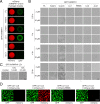Distinct roles of hnRNPH1 low-complexity domains in splicing and transcription
- PMID: 34873036
- PMCID: PMC8685725
- DOI: 10.1073/pnas.2109668118
Distinct roles of hnRNPH1 low-complexity domains in splicing and transcription
Abstract
Heterogeneous nuclear ribonucleoproteins (hnRNPs) represent a large family of RNA-binding proteins that control key events in RNA biogenesis under both normal and diseased cellular conditions. The low-complexity (LC) domain of hnRNPs can become liquid-like droplets or reversible amyloid-like polymers by phase separation. Yet, whether phase separation of the LC domains contributes to physiological functions of hnRNPs remains unclear. hnRNPH1 contains two LC domains, LC1 and LC2. Here, we show that reversible phase separation of the LC1 domain is critical for both interaction with different kinds of RNA-binding proteins and control of the alternative-splicing activity of hnRNPH1. Interestingly, although not required for phase separation, the LC2 domain contributes to the robust transcriptional activation of hnRNPH1 when fused to the DNA-binding domain, as found recently in acute lymphoblastic leukemia. Our data suggest that the ability of the LC1 domain to phase-separate into reversible polymers or liquid-like droplets is essential for function of hnRNPH1 as an alternative RNA-splicing regulator, whereas the LC2 domain may contribute to the aberrant transcriptional activity responsible for cancer transformation.
Keywords: hnRNPH1; low-complexity domain; phase separation; splicing; transcription.
Copyright © 2021 the Author(s). Published by PNAS.
Conflict of interest statement
The authors declare no competing interest.
Figures





Similar articles
-
Protein and gene expression characteristics of heterogeneous nuclear ribonucleoprotein H1 in esophageal squamous cell carcinoma.World J Gastroenterol. 2016 Aug 28;22(32):7322-31. doi: 10.3748/wjg.v22.i32.7322. World J Gastroenterol. 2016. PMID: 27621578 Free PMC article.
-
MACC1 enhances an oncogenic RNA splicing of IRAK1 through interacting with HNRNPH1 in lung adenocarcinoma.J Cell Physiol. 2024 Dec;239(12):e31426. doi: 10.1002/jcp.31426. Epub 2024 Sep 2. J Cell Physiol. 2024. PMID: 39221900
-
[The splicing factor HNRNPH1 regulates Circ-MYOCD back-splicing to modulate the course of cardiac hypertrophy].Nan Fang Yi Ke Da Xue Xue Bao. 2025 Mar 20;45(3):587-594. doi: 10.12122/j.issn.1673-4254.2025.03.16. Nan Fang Yi Ke Da Xue Xue Bao. 2025. PMID: 40159973 Free PMC article. Chinese.
-
hnRNPH1: A Multifaceted Regulator in RNA Processing and Disease Pathogenesis.Int J Mol Sci. 2025 May 28;26(11):5159. doi: 10.3390/ijms26115159. Int J Mol Sci. 2025. PMID: 40507967 Free PMC article. Review.
-
Heterogeneous nuclear ribonucleoprotein A1 in health and neurodegenerative disease: from structural insights to post-transcriptional regulatory roles.Mol Cell Neurosci. 2013 Sep;56:436-46. doi: 10.1016/j.mcn.2012.12.002. Epub 2012 Dec 14. Mol Cell Neurosci. 2013. PMID: 23247072 Review.
Cited by
-
Decoding Missense Variants by Incorporating Phase Separation via Machine Learning.Nat Commun. 2024 Sep 27;15(1):8279. doi: 10.1038/s41467-024-52580-3. Nat Commun. 2024. PMID: 39333476 Free PMC article.
-
MS0621, a novel small-molecule modulator of Ewing sarcoma chromatin accessibility, interacts with an RNA-associated macromolecular complex and influences RNA splicing.Front Oncol. 2023 Jan 30;13:1099550. doi: 10.3389/fonc.2023.1099550. eCollection 2023. Front Oncol. 2023. PMID: 36793594 Free PMC article.
-
Phase separation of low-complexity domains in cellular function and disease.Exp Mol Med. 2022 Sep;54(9):1412-1422. doi: 10.1038/s12276-022-00857-2. Epub 2022 Sep 29. Exp Mol Med. 2022. PMID: 36175485 Free PMC article. Review.
-
METTL3-Mediated LINC00475 Alternative Splicing Promotes Glioma Progression by Inducing Mitochondrial Fission.Research (Wash D C). 2024 Feb 23;7:0324. doi: 10.34133/research.0324. eCollection 2024. Research (Wash D C). 2024. PMID: 38405130 Free PMC article.
-
Splicing regulation through biomolecular condensates and membraneless organelles.Nat Rev Mol Cell Biol. 2024 Sep;25(9):683-700. doi: 10.1038/s41580-024-00739-7. Epub 2024 May 21. Nat Rev Mol Cell Biol. 2024. PMID: 38773325 Free PMC article. Review.
References
-
- Kato M., McKnight S. L., A solid-state conceptualization of information transfer from gene to message to protein. Annu. Rev. Biochem. 87, 351–390 (2018). - PubMed
Publication types
MeSH terms
Substances
LinkOut - more resources
Full Text Sources

